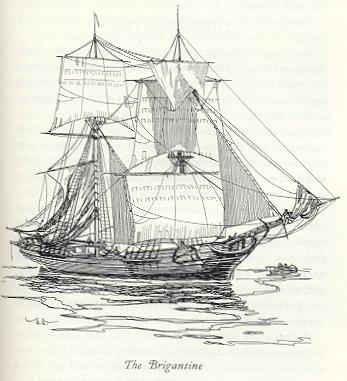Pirate Ships

A brigantine, one of the most successful types
of pirate vessels due to its combination of
good size, speed and maneuverability.
During the era of buccaneers and the Golden Age of Piracy (1690-1725), pirates in the Caribbean adapted cargo vessels for their own use. Captured ships were often turned into pirate ships. The best pirate ships were fast enough to catch or escape from powerful enemies.
Smaller, lighter ships like sloops, brigantines, or schooners were preferred.
Sloops were the most common ships in Caribbean waters in the 17th and 18th centuries. The name was used to describe a single-masted craft with a large spread of sail. They were fast and highly maneuverable, carrying a crew of 75 men and 14 small cannon.
Brigantines were two-masted ships in use for coastal trading in American waters. The foremasts carried square-rigged sails, while the mainmasts carried a fore-and-aft-rigged mainsail and square-rigged top sail. They were up to 80 feet long and could carry 100 men and 12 small cannon.
Most larger pirate ships were made of cedar and oak. They had a raised deck near the bow called a forecastle and a higher deck near the stern called the sterncastle. The deck on top of the sterncastle was called the quarterdeck. This was where the helm or the wheel was located. Most navigational decisions were made on the quarterdeck. Just under the quarterdeck were the captain’s cabin and officer’s quarters.
The gun deck was just beneath the ship’s main deck. This was where the cannon were located.
Gunpowder was stored in the ship’s magazine. This was usually on a lower deck near the stern, well away from the ship’s galley which held the stove. The risk of fire or explosion was very great on a pirate ship. The slightest spark could ignite the gunpowder in the magazine and destroy the entire ship. Pirates were not allowed to smoke below decks.
The ship’s water supply was stored in large barrels that were placed down in the hold to act as ballast. Sails were stored in the driest area below decks so they would not rot.
Meat was salted down and packed in barrels, but it often rotted and sailors were forced to fish or go ashore to hunt for fresh meat. Pirates also ate dry, hard biscuits called ‘hard tack.’ They drank rum or grog which was rum mixed with warm water and lemon.
The regular crew slept below in cramped and dirty quarters. The smell of bilge water was foul and rats were ever-present on board.
A ship was steered with a huge wooden rudder that was linked to the ship’s wheel. The anchor could weigh up to 3,000 pounds and had to be raised and lowered with a winch called a ‘capstan.’ Five or six pirates would turn the capstan slowly around on its axis to wind in the anchor rope.
Ropes were made of hemp and made up the ship’s rigging that supported the sails and masts. Every seafarer knew how to repair ropes and fix broken pulleys.
Sails was made of tough canvas called ‘sailcloth,’ woven from hemp, cotton or linen.
Pirate crews had to climb ropes called ‘ratlines’ to get up to the yardarms which held the sails to the masts. From there, they could take in or let out sails, depending on the wind conditions.
Very interesting information about their way of life; I would love to learn more about that time.
I could picture the character as I read along; I would have liked to have carried on reading.
This is facinating
Can you put more information about the ships because I’m doing some